Policy Brief: Addressing Drug Affordability in Nursing Leadership
VerifiedAdded on 2023/04/23
|6
|1361
|240
Report
AI Summary
This policy brief, prepared from a nursing leadership perspective, addresses the critical issue of drug affordability in the United States. It begins by outlining the problem, highlighting the significantly higher drug prices in the US compared to other countries and the resulting difficulties faced by low-income individuals and the elderly in accessing essential medications. The brief then delves into the nature and magnitude of the problem, citing statistics on drug costs and the impact on vulnerable populations. It identifies the most affected groups, risk factors such as unequal negotiation power and high prescription costs, and the economic and social consequences, including increased mortality and morbidity rates. The report recommends cost-effective action steps, such as government negotiation with pharmaceutical companies, promoting generic drugs, and implementing value-based drug pricing, to improve access to medications and enhance the standard of living for all citizens. The policy brief emphasizes the need for legislative changes and healthcare policies to address the crisis.

Running Head: NURSING LEADERSHIP
Nursing leadership
Name of the student:
Name of the university
Author note:
Nursing leadership
Name of the student:
Name of the university
Author note:
Paraphrase This Document
Need a fresh take? Get an instant paraphrase of this document with our AI Paraphraser
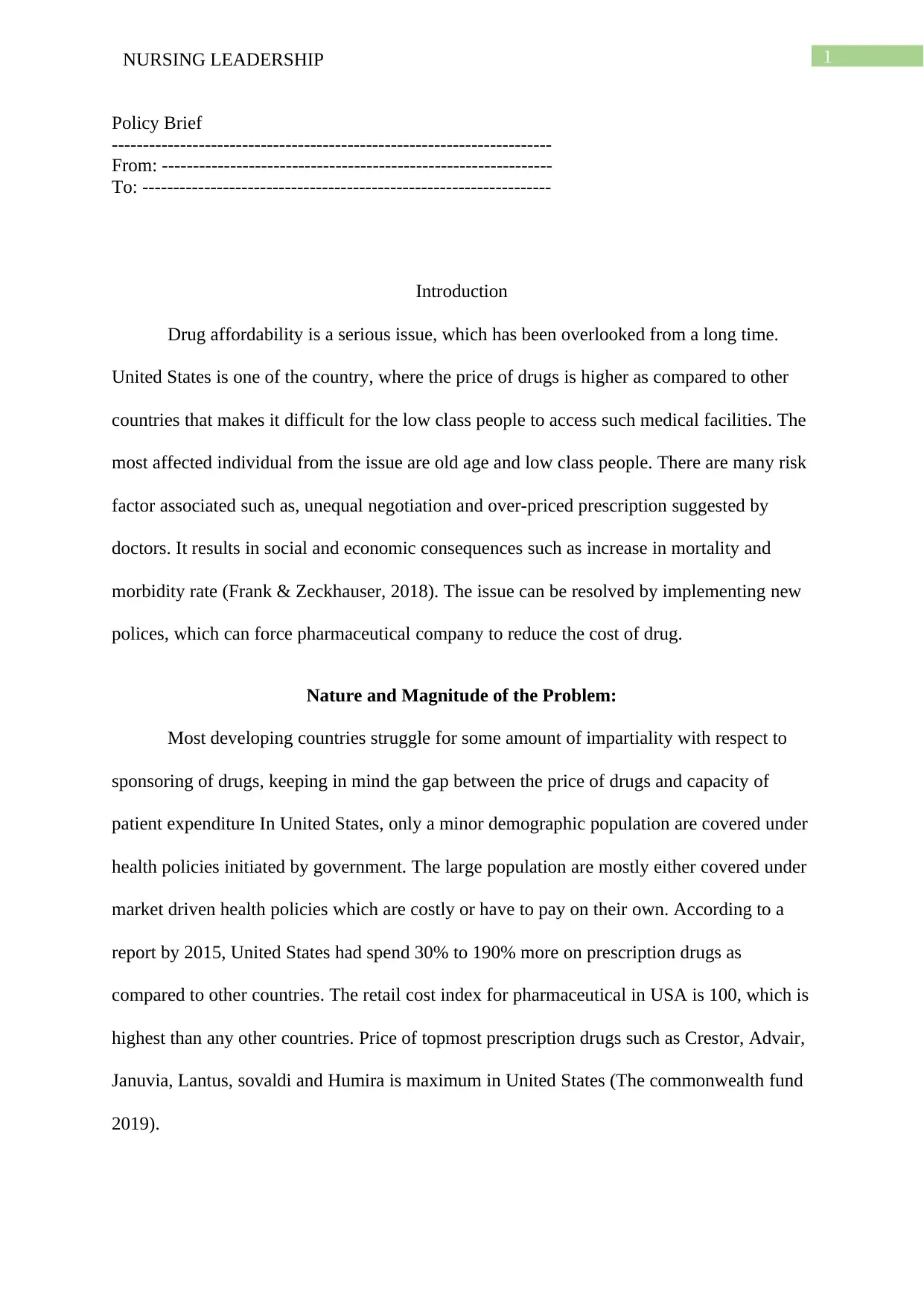
1NURSING LEADERSHIP
Policy Brief
-----------------------------------------------------------------------
From: ---------------------------------------------------------------
To: ------------------------------------------------------------------
Introduction
Drug affordability is a serious issue, which has been overlooked from a long time.
United States is one of the country, where the price of drugs is higher as compared to other
countries that makes it difficult for the low class people to access such medical facilities. The
most affected individual from the issue are old age and low class people. There are many risk
factor associated such as, unequal negotiation and over-priced prescription suggested by
doctors. It results in social and economic consequences such as increase in mortality and
morbidity rate (Frank & Zeckhauser, 2018). The issue can be resolved by implementing new
polices, which can force pharmaceutical company to reduce the cost of drug.
Nature and Magnitude of the Problem:
Most developing countries struggle for some amount of impartiality with respect to
sponsoring of drugs, keeping in mind the gap between the price of drugs and capacity of
patient expenditure In United States, only a minor demographic population are covered under
health policies initiated by government. The large population are mostly either covered under
market driven health policies which are costly or have to pay on their own. According to a
report by 2015, United States had spend 30% to 190% more on prescription drugs as
compared to other countries. The retail cost index for pharmaceutical in USA is 100, which is
highest than any other countries. Price of topmost prescription drugs such as Crestor, Advair,
Januvia, Lantus, sovaldi and Humira is maximum in United States (The commonwealth fund
2019).
Policy Brief
-----------------------------------------------------------------------
From: ---------------------------------------------------------------
To: ------------------------------------------------------------------
Introduction
Drug affordability is a serious issue, which has been overlooked from a long time.
United States is one of the country, where the price of drugs is higher as compared to other
countries that makes it difficult for the low class people to access such medical facilities. The
most affected individual from the issue are old age and low class people. There are many risk
factor associated such as, unequal negotiation and over-priced prescription suggested by
doctors. It results in social and economic consequences such as increase in mortality and
morbidity rate (Frank & Zeckhauser, 2018). The issue can be resolved by implementing new
polices, which can force pharmaceutical company to reduce the cost of drug.
Nature and Magnitude of the Problem:
Most developing countries struggle for some amount of impartiality with respect to
sponsoring of drugs, keeping in mind the gap between the price of drugs and capacity of
patient expenditure In United States, only a minor demographic population are covered under
health policies initiated by government. The large population are mostly either covered under
market driven health policies which are costly or have to pay on their own. According to a
report by 2015, United States had spend 30% to 190% more on prescription drugs as
compared to other countries. The retail cost index for pharmaceutical in USA is 100, which is
highest than any other countries. Price of topmost prescription drugs such as Crestor, Advair,
Januvia, Lantus, sovaldi and Humira is maximum in United States (The commonwealth fund
2019).
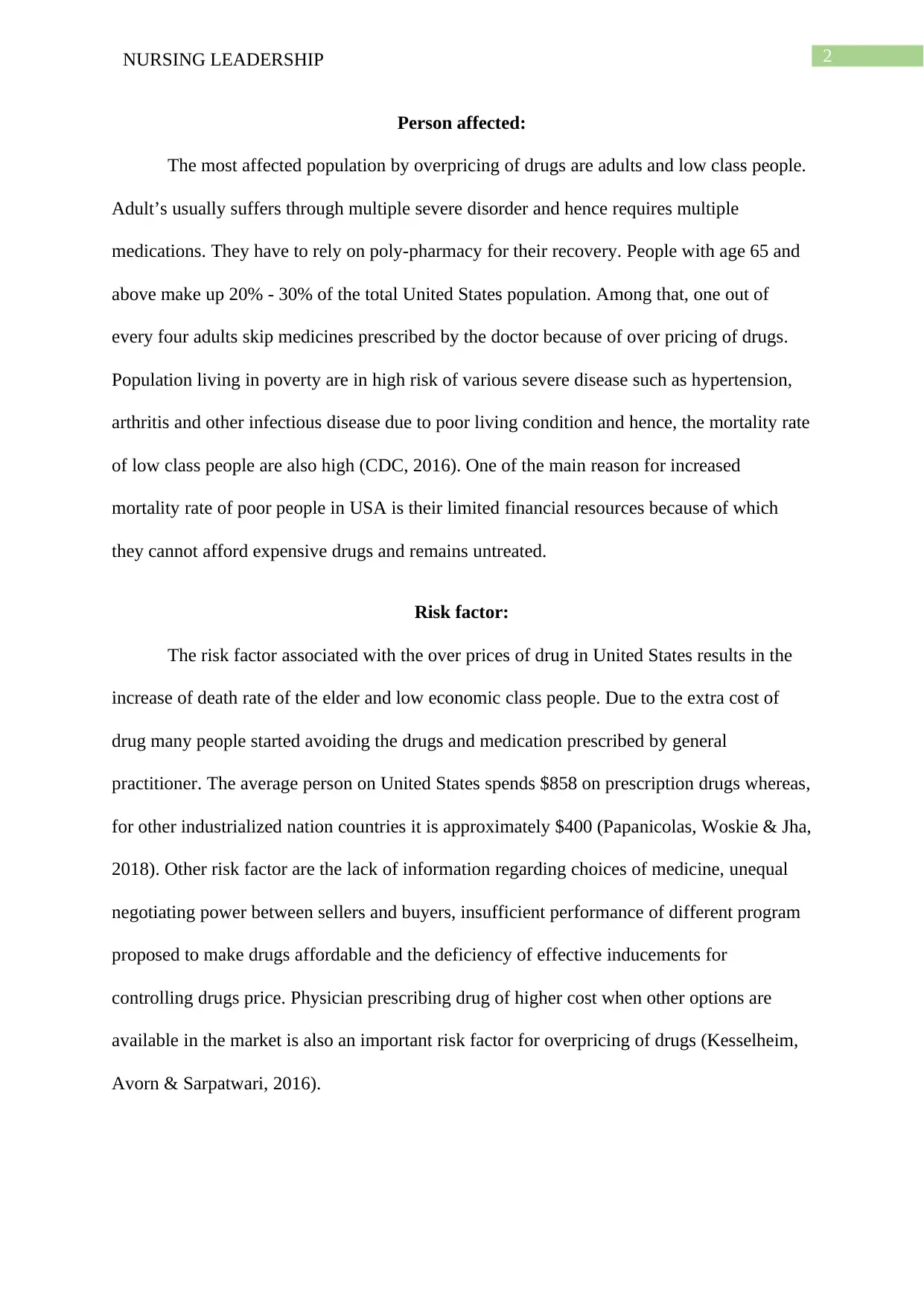
2NURSING LEADERSHIP
Person affected:
The most affected population by overpricing of drugs are adults and low class people.
Adult’s usually suffers through multiple severe disorder and hence requires multiple
medications. They have to rely on poly-pharmacy for their recovery. People with age 65 and
above make up 20% - 30% of the total United States population. Among that, one out of
every four adults skip medicines prescribed by the doctor because of over pricing of drugs.
Population living in poverty are in high risk of various severe disease such as hypertension,
arthritis and other infectious disease due to poor living condition and hence, the mortality rate
of low class people are also high (CDC, 2016). One of the main reason for increased
mortality rate of poor people in USA is their limited financial resources because of which
they cannot afford expensive drugs and remains untreated.
Risk factor:
The risk factor associated with the over prices of drug in United States results in the
increase of death rate of the elder and low economic class people. Due to the extra cost of
drug many people started avoiding the drugs and medication prescribed by general
practitioner. The average person on United States spends $858 on prescription drugs whereas,
for other industrialized nation countries it is approximately $400 (Papanicolas, Woskie & Jha,
2018). Other risk factor are the lack of information regarding choices of medicine, unequal
negotiating power between sellers and buyers, insufficient performance of different program
proposed to make drugs affordable and the deficiency of effective inducements for
controlling drugs price. Physician prescribing drug of higher cost when other options are
available in the market is also an important risk factor for overpricing of drugs (Kesselheim,
Avorn & Sarpatwari, 2016).
Person affected:
The most affected population by overpricing of drugs are adults and low class people.
Adult’s usually suffers through multiple severe disorder and hence requires multiple
medications. They have to rely on poly-pharmacy for their recovery. People with age 65 and
above make up 20% - 30% of the total United States population. Among that, one out of
every four adults skip medicines prescribed by the doctor because of over pricing of drugs.
Population living in poverty are in high risk of various severe disease such as hypertension,
arthritis and other infectious disease due to poor living condition and hence, the mortality rate
of low class people are also high (CDC, 2016). One of the main reason for increased
mortality rate of poor people in USA is their limited financial resources because of which
they cannot afford expensive drugs and remains untreated.
Risk factor:
The risk factor associated with the over prices of drug in United States results in the
increase of death rate of the elder and low economic class people. Due to the extra cost of
drug many people started avoiding the drugs and medication prescribed by general
practitioner. The average person on United States spends $858 on prescription drugs whereas,
for other industrialized nation countries it is approximately $400 (Papanicolas, Woskie & Jha,
2018). Other risk factor are the lack of information regarding choices of medicine, unequal
negotiating power between sellers and buyers, insufficient performance of different program
proposed to make drugs affordable and the deficiency of effective inducements for
controlling drugs price. Physician prescribing drug of higher cost when other options are
available in the market is also an important risk factor for overpricing of drugs (Kesselheim,
Avorn & Sarpatwari, 2016).
⊘ This is a preview!⊘
Do you want full access?
Subscribe today to unlock all pages.

Trusted by 1+ million students worldwide
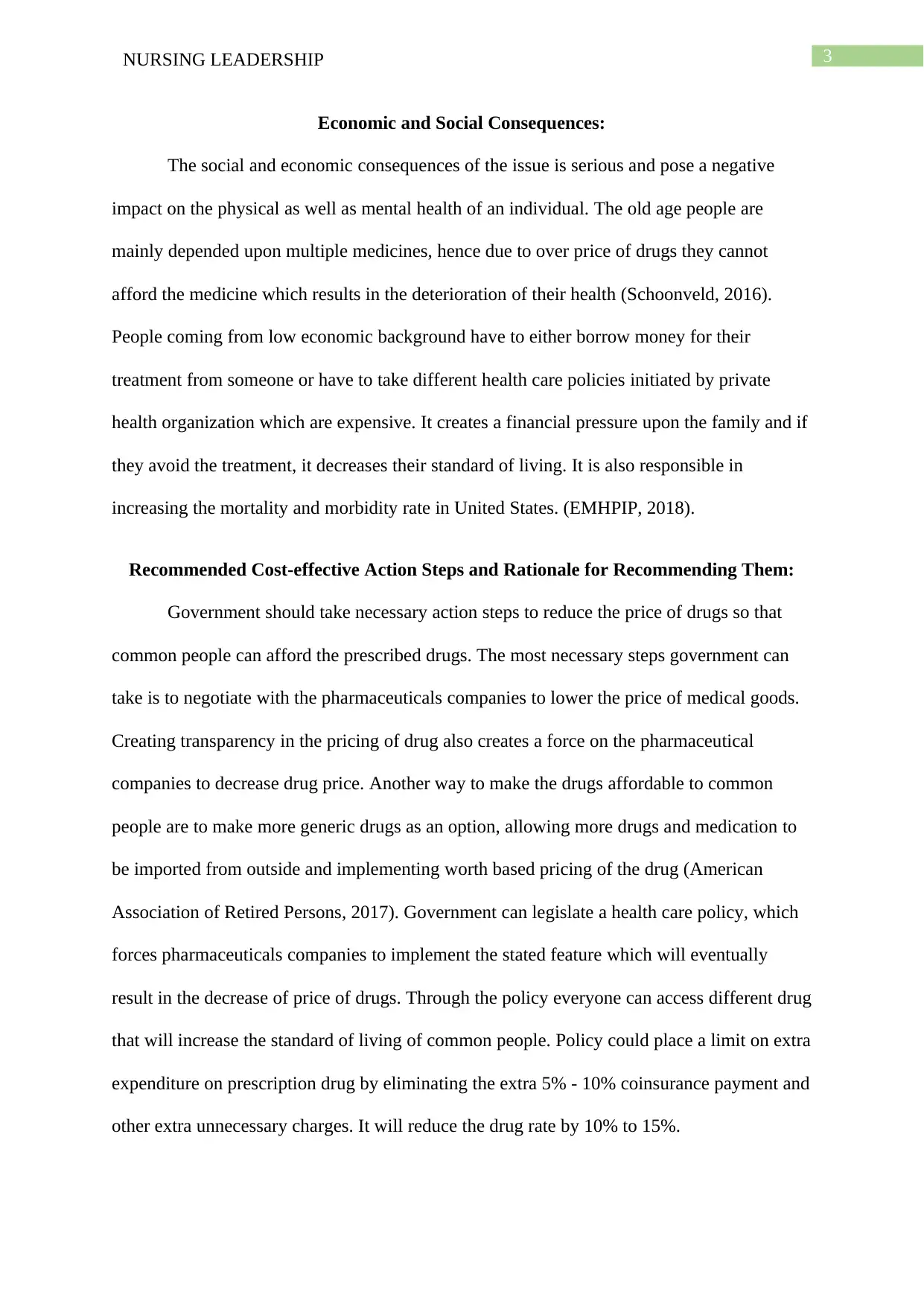
3NURSING LEADERSHIP
Economic and Social Consequences:
The social and economic consequences of the issue is serious and pose a negative
impact on the physical as well as mental health of an individual. The old age people are
mainly depended upon multiple medicines, hence due to over price of drugs they cannot
afford the medicine which results in the deterioration of their health (Schoonveld, 2016).
People coming from low economic background have to either borrow money for their
treatment from someone or have to take different health care policies initiated by private
health organization which are expensive. It creates a financial pressure upon the family and if
they avoid the treatment, it decreases their standard of living. It is also responsible in
increasing the mortality and morbidity rate in United States. (EMHPIP, 2018).
Recommended Cost-effective Action Steps and Rationale for Recommending Them:
Government should take necessary action steps to reduce the price of drugs so that
common people can afford the prescribed drugs. The most necessary steps government can
take is to negotiate with the pharmaceuticals companies to lower the price of medical goods.
Creating transparency in the pricing of drug also creates a force on the pharmaceutical
companies to decrease drug price. Another way to make the drugs affordable to common
people are to make more generic drugs as an option, allowing more drugs and medication to
be imported from outside and implementing worth based pricing of the drug (American
Association of Retired Persons, 2017). Government can legislate a health care policy, which
forces pharmaceuticals companies to implement the stated feature which will eventually
result in the decrease of price of drugs. Through the policy everyone can access different drug
that will increase the standard of living of common people. Policy could place a limit on extra
expenditure on prescription drug by eliminating the extra 5% - 10% coinsurance payment and
other extra unnecessary charges. It will reduce the drug rate by 10% to 15%.
Economic and Social Consequences:
The social and economic consequences of the issue is serious and pose a negative
impact on the physical as well as mental health of an individual. The old age people are
mainly depended upon multiple medicines, hence due to over price of drugs they cannot
afford the medicine which results in the deterioration of their health (Schoonveld, 2016).
People coming from low economic background have to either borrow money for their
treatment from someone or have to take different health care policies initiated by private
health organization which are expensive. It creates a financial pressure upon the family and if
they avoid the treatment, it decreases their standard of living. It is also responsible in
increasing the mortality and morbidity rate in United States. (EMHPIP, 2018).
Recommended Cost-effective Action Steps and Rationale for Recommending Them:
Government should take necessary action steps to reduce the price of drugs so that
common people can afford the prescribed drugs. The most necessary steps government can
take is to negotiate with the pharmaceuticals companies to lower the price of medical goods.
Creating transparency in the pricing of drug also creates a force on the pharmaceutical
companies to decrease drug price. Another way to make the drugs affordable to common
people are to make more generic drugs as an option, allowing more drugs and medication to
be imported from outside and implementing worth based pricing of the drug (American
Association of Retired Persons, 2017). Government can legislate a health care policy, which
forces pharmaceuticals companies to implement the stated feature which will eventually
result in the decrease of price of drugs. Through the policy everyone can access different drug
that will increase the standard of living of common people. Policy could place a limit on extra
expenditure on prescription drug by eliminating the extra 5% - 10% coinsurance payment and
other extra unnecessary charges. It will reduce the drug rate by 10% to 15%.
Paraphrase This Document
Need a fresh take? Get an instant paraphrase of this document with our AI Paraphraser
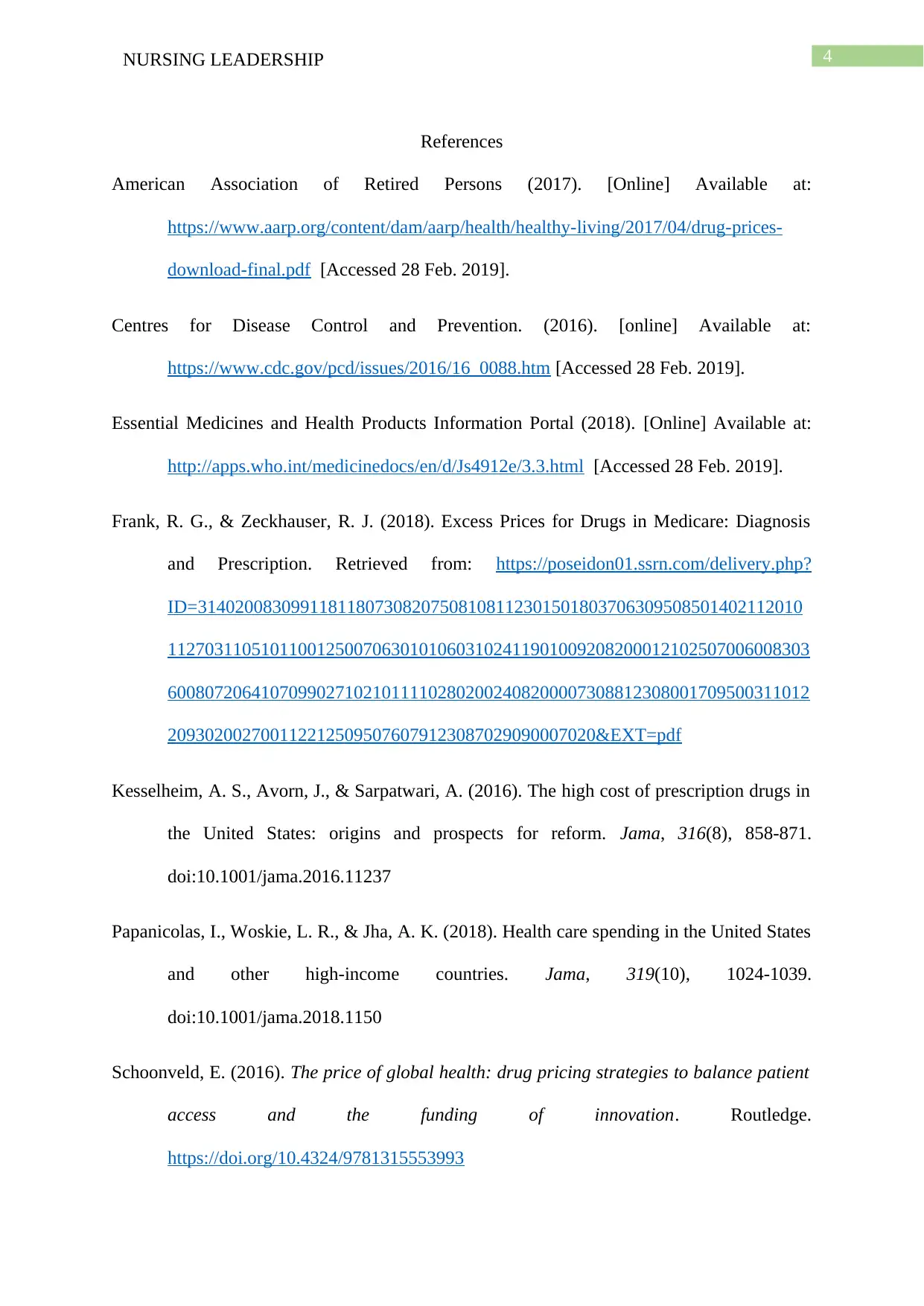
4NURSING LEADERSHIP
References
American Association of Retired Persons (2017). [Online] Available at:
https://www.aarp.org/content/dam/aarp/health/healthy-living/2017/04/drug-prices-
download-final.pdf [Accessed 28 Feb. 2019].
Centres for Disease Control and Prevention. (2016). [online] Available at:
https://www.cdc.gov/pcd/issues/2016/16_0088.htm [Accessed 28 Feb. 2019].
Essential Medicines and Health Products Information Portal (2018). [Online] Available at:
http://apps.who.int/medicinedocs/en/d/Js4912e/3.3.html [Accessed 28 Feb. 2019].
Frank, R. G., & Zeckhauser, R. J. (2018). Excess Prices for Drugs in Medicare: Diagnosis
and Prescription. Retrieved from: https://poseidon01.ssrn.com/delivery.php?
ID=31402008309911811807308207508108112301501803706309508501402112010
112703110510110012500706301010603102411901009208200012102507006008303
600807206410709902710210111102802002408200007308812308001709500311012
2093020027001122125095076079123087029090007020&EXT=pdf
Kesselheim, A. S., Avorn, J., & Sarpatwari, A. (2016). The high cost of prescription drugs in
the United States: origins and prospects for reform. Jama, 316(8), 858-871.
doi:10.1001/jama.2016.11237
Papanicolas, I., Woskie, L. R., & Jha, A. K. (2018). Health care spending in the United States
and other high-income countries. Jama, 319(10), 1024-1039.
doi:10.1001/jama.2018.1150
Schoonveld, E. (2016). The price of global health: drug pricing strategies to balance patient
access and the funding of innovation. Routledge.
https://doi.org/10.4324/9781315553993
References
American Association of Retired Persons (2017). [Online] Available at:
https://www.aarp.org/content/dam/aarp/health/healthy-living/2017/04/drug-prices-
download-final.pdf [Accessed 28 Feb. 2019].
Centres for Disease Control and Prevention. (2016). [online] Available at:
https://www.cdc.gov/pcd/issues/2016/16_0088.htm [Accessed 28 Feb. 2019].
Essential Medicines and Health Products Information Portal (2018). [Online] Available at:
http://apps.who.int/medicinedocs/en/d/Js4912e/3.3.html [Accessed 28 Feb. 2019].
Frank, R. G., & Zeckhauser, R. J. (2018). Excess Prices for Drugs in Medicare: Diagnosis
and Prescription. Retrieved from: https://poseidon01.ssrn.com/delivery.php?
ID=31402008309911811807308207508108112301501803706309508501402112010
112703110510110012500706301010603102411901009208200012102507006008303
600807206410709902710210111102802002408200007308812308001709500311012
2093020027001122125095076079123087029090007020&EXT=pdf
Kesselheim, A. S., Avorn, J., & Sarpatwari, A. (2016). The high cost of prescription drugs in
the United States: origins and prospects for reform. Jama, 316(8), 858-871.
doi:10.1001/jama.2016.11237
Papanicolas, I., Woskie, L. R., & Jha, A. K. (2018). Health care spending in the United States
and other high-income countries. Jama, 319(10), 1024-1039.
doi:10.1001/jama.2018.1150
Schoonveld, E. (2016). The price of global health: drug pricing strategies to balance patient
access and the funding of innovation. Routledge.
https://doi.org/10.4324/9781315553993
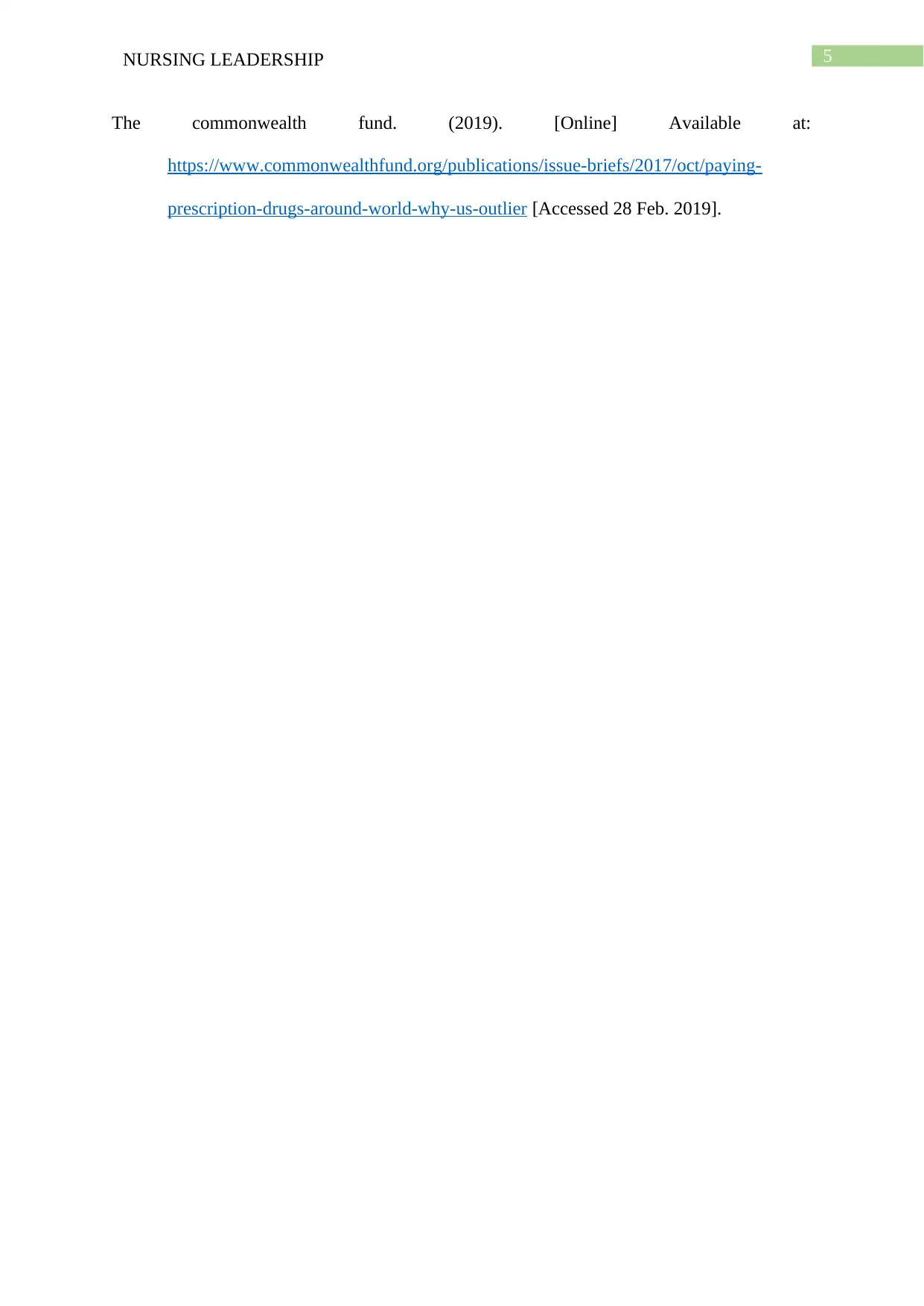
5NURSING LEADERSHIP
The commonwealth fund. (2019). [Online] Available at:
https://www.commonwealthfund.org/publications/issue-briefs/2017/oct/paying-
prescription-drugs-around-world-why-us-outlier [Accessed 28 Feb. 2019].
The commonwealth fund. (2019). [Online] Available at:
https://www.commonwealthfund.org/publications/issue-briefs/2017/oct/paying-
prescription-drugs-around-world-why-us-outlier [Accessed 28 Feb. 2019].
⊘ This is a preview!⊘
Do you want full access?
Subscribe today to unlock all pages.

Trusted by 1+ million students worldwide
1 out of 6
Related Documents
Your All-in-One AI-Powered Toolkit for Academic Success.
+13062052269
info@desklib.com
Available 24*7 on WhatsApp / Email
![[object Object]](/_next/static/media/star-bottom.7253800d.svg)
Unlock your academic potential
Copyright © 2020–2025 A2Z Services. All Rights Reserved. Developed and managed by ZUCOL.





